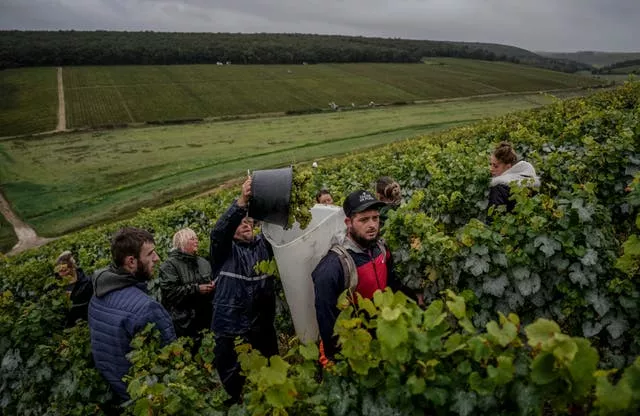French wine makers have warned the 2024 “millesime” – wine from a single year’s harvest – will be in short supply after one of the wettest years on record.
Severe conditions across much of France’s wine country amid a changing climate in 2024 came after years of challenges to vineyards and wine quality caused by drought and heat.
The harvest at the Domaine Roland Lavantureux winery, which produces prized Chardonnay grapes that are eventually transformed into the bright and high-end Premier Cru, lasted just nine days – about half the usual time – meaning 2024 bottles will be available in smaller quantities than normal.
A year of unpredictably harsh weather marked by frost, hail, record rainfall and the spread of a dangerous fungus has left Chablis growers on edge.
Winemaker David Lavantureux, who followed in the footsteps of his father Roland in the industry, said: “I have been working here since 2010. This is my most difficult year.
“All the old-timers will tell you the same thing. It’s been a very difficult year because the weather has been so unpredictable. We have not been spared a single thing.”

The ordeal began in April with the frost, then a double hailstorm pummelled the region in May. Relentless rain followed, right up to the harvest.
According to the Burgundy wine federation, nearly 2,500 acres of vines in the Chablis country were affected by the May storm, and the excess moisture allowed a destructive mildew fungus to thrive.
Once entrenched, the disease causes huge crop losses and can also affect wine quality.
Together with his brother Arnaud, David Lavantureux fought hard to try and control mildew with various treatments, but they were washed away by the rain and did not prove effective.
“On our estate, we’re looking at losses of 60 to 65%,” David Lavantureux said. “It’s a low-yield year.”
Overall production in wine growing regions is estimated to be 39.3 million hectolitres, 18% down on 2023 and 11% behind the average for the past five years.
Arnaud Lavantureux said: “It’s been a very tough year, both physically and mentally. We’re relieved the harvest is over. I’m exhausted.”
The challenges of this year will inevitably influence the wines produced at the family winery, resulting in a 2024 vintage with distinct characteristics.

“Balances are not at all the same,” adds Arnaud. “There’s more acidity. Maturity is less optimal. But the goal is to craft the wine so that, in the end, the balance is as perfect as possible.”
Located in the northern part of the Bourgogne region, the vineyards of Chablis have traditionally benefited from a favourable climate – cold winters, hot summers and annual rainfall between 650-700mm.
But climate change is altering those conditions, bringing unseasonably mild weather, more abundant rainfall, and recurrent spring frosts that were less common in the past.
The frost damage is particularly frustrating. A similar phenomenon hit French vineyards in recent years, leading to big financial losses. Scientists believe the damaging 2021 frost was made more likely by climate change.
David Lavantureux said: “There was a period when we thought that with global warming setting in, Chablis would be safe from frost. Finally, over the last 15 years, it’s come back even stronger.”
To adapt, winemakers have been adopting creative solutions. Cutting the wines later helps delay bud burst and reduce the vulnerability to late frost, while keeping a larger foliage above the fruit shields the grapes from the scorching sun in hot summers.

During frost threats, many growers use expensive methods such as lighting candles in the vineyards. They also install electric lines to warm the vines, or spray water on the buds to create a thin ice layer that ensures the blossom’s temperature remains around freezing point but doesn’t dip much lower.
Throughout the Burgundy region, anti-hail devices have also been deployed in a bid to lessen the intensity of hailstorms.
“It helps reduce risk, but it’s never 100% protection,” David Lavantureux said. “We saw that again this year with several hailstorms, two of which were particularly severe.”
Fortunately for the Lavantureux family, two very good years in 2022 and 2023 should help mitigate the financial losses induced by the reduced 2024 harvest as international demand for Chablis remains solid, especially in the United States.
In June, the Burgundy wine association said Chablis wine exports to the US reached three million bottles, generating 368 million euros (£307 million) – a 19% increase compared to the previous year.
“We’ve put this harvest behind us,” Arnaud Lavantureux said. “Now it’s time to think on the next one.”







